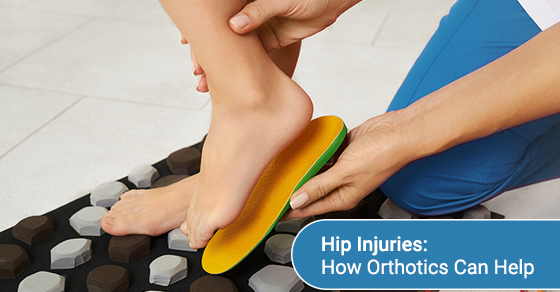Custom orthotics can help treat a number of conditions including problems with the hip. Orthotics are specially designed devices that control foot function and they can correct alignment issues in your feet and legs to improve stability and alleviate pain. Custom orthotics are very different from over-the-counter insoles because they are specially made to conform to the unique shape of your feet. Orthotics can reduce painful muscle strain and improper movement by modifying weight-bearing areas. You may be wondering how correcting these problems would benefit hip injuries. But both the feet and hips are interconnected, with each having a significant impact on the other. Let’s explore how orthotics can help.
Purpose of the Hips
The hips are the largest joints in your body. Along with the knees, they are responsible for supporting your weight as you stand and walk. A cushion of cartilage helps prevent friction as the hip bone moves around in the socket. Although the hip is quite durable, this cushion can eventually wear thin with age and prolonged use. Not only does the cartilage break down, but so can the bones, tendons and muscles surrounding the hip.
Here are some of the conditions that can cause hip problems:
- Arthritis – Osteoarthritis, Rheumatoid arthritis, Septic arthritis
- Cancer – Bone cancer, Leukemia
- General Injuries – Bursitis (joint inflammation), Dislocation, Hip Labral Tear
Depending on the condition that’s causing the problem, you could feel pain in a number of different areas. These areas include inside or outside the hip joint, thigh, buttocks and even the groin.
Impact of Foot Function on Hip Injuries
Poor walking habits can cause or worsen hip injuries. Issues are often caused by overpronation. Pronation refers to the natural movement of your feet when walking or running. In overpronation, your ankle will roll too far downward and inward with every step. The ankle keeps on rolling when your toes should be starting to push off. This causes the big toe and second toe to do all of the push-off while the foot twists more and more with each step. As you walk or run, the entire body will begin to absorb shock in all the wrong places. There will be a tightness in your entire foot that will trigger a chain reaction. This reaction will begin at the shin, then up to the knee and then the hip flexors—ultimately causing pain and injury.
Supination is another common condition that can cause hip injury. Supination happens when your ankle rolls to the outside edge of the foot. The foot naturally supinates, or turns, when you push off with your toe as the heel first lifts off the ground. But if this supination continues through the toe-off, the weight isn’t being transferred properly to the big toe. This means all the work is being done by the outer portions of your foot and smaller toes. Over time, this can create extra stress on the foot which will cause that painful chain reaction up to your hips.
How Custom Orthotics Can Help
Custom orthotics are very popular in treating hip problems. This is because many physiotherapists believe in healing from the ground up. Results are more successful when treatment addresses the entire body, rather than trying to reduce pain only in the affected area.
A custom orthotic should account for the following:
- Alignment – Re-aligns the foot by redirecting certain motions that happen during the gait cycle
- Support – Provides support to the ankle, preventing overpronation or supination (rolling motion to the outside edge of the foot)
- Stability – Offers necessary support base so we can have control and balance of our bodies from the ground up
If you’re interested in custom orthotics, visit a qualified physiotherapist. The team at Focus Physiotherapy has the expertise to determine whether orthotics is the right treatment option for you. The process will entail the following: a medical examination of your foot, followed by a biomechanical examination, then a gait analysis of your walking patterns. The biomechanical assessment will look at any bone misalignments as this can cause a whole series of problems. Meanwhile, the gait analysis will determine whether one leg is shorter than the other, or if you have flat feet.
Depending on your assessment results, you’ll receive either functional orthotics or accommodative ones. Functional orthotics are designed to control abnormal movements while providing stability. Athletes and people who engage in a lot of physical activity can benefit. They’re usually made of a semi-rigid material like plastic or graphite.
Accommodative orthotics are softer because they’re designed to provide additional support and cushioning. These types of orthotics are helpful for seniors who have sensitive feet, or those who are prone to calluses and ulcerations. There are times, however, when a combination of functional and accommodative orthotics are necessary to treat the unique conditions of your feet.
Whether you’re suffering from a hip injury or joint inflammation, ask your physiotherapist if orthotics are a good solution for you.
For more information on custom orthotics, please call Focus Physiotherapy at 1-888-341-6101 or contact us here.

